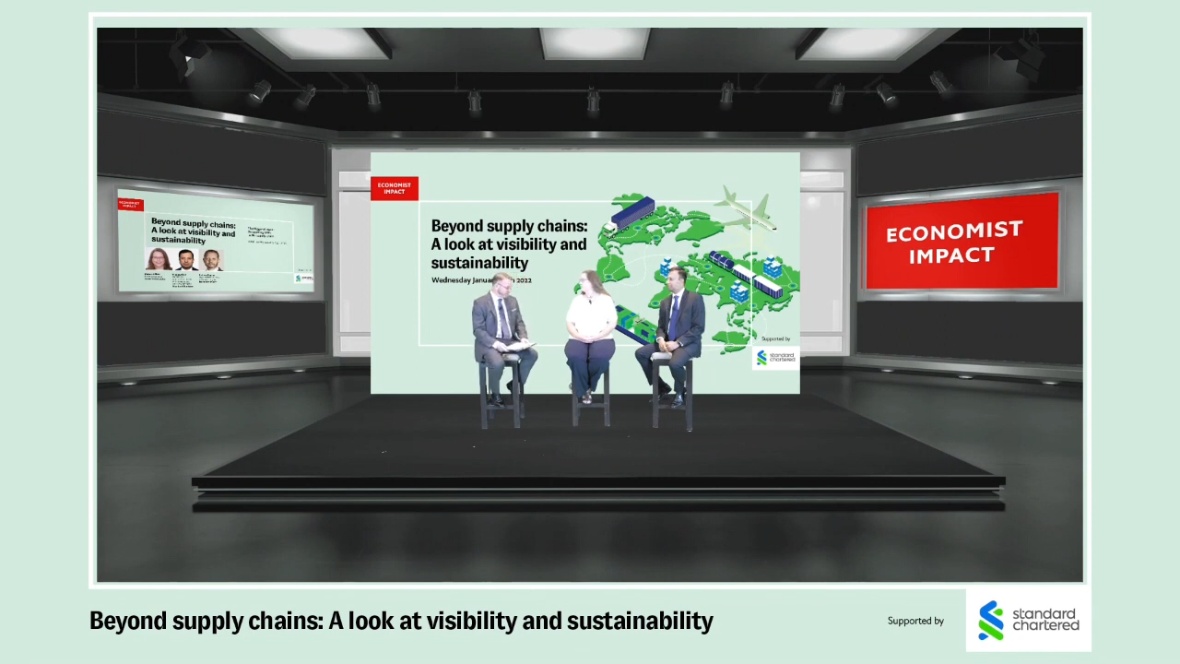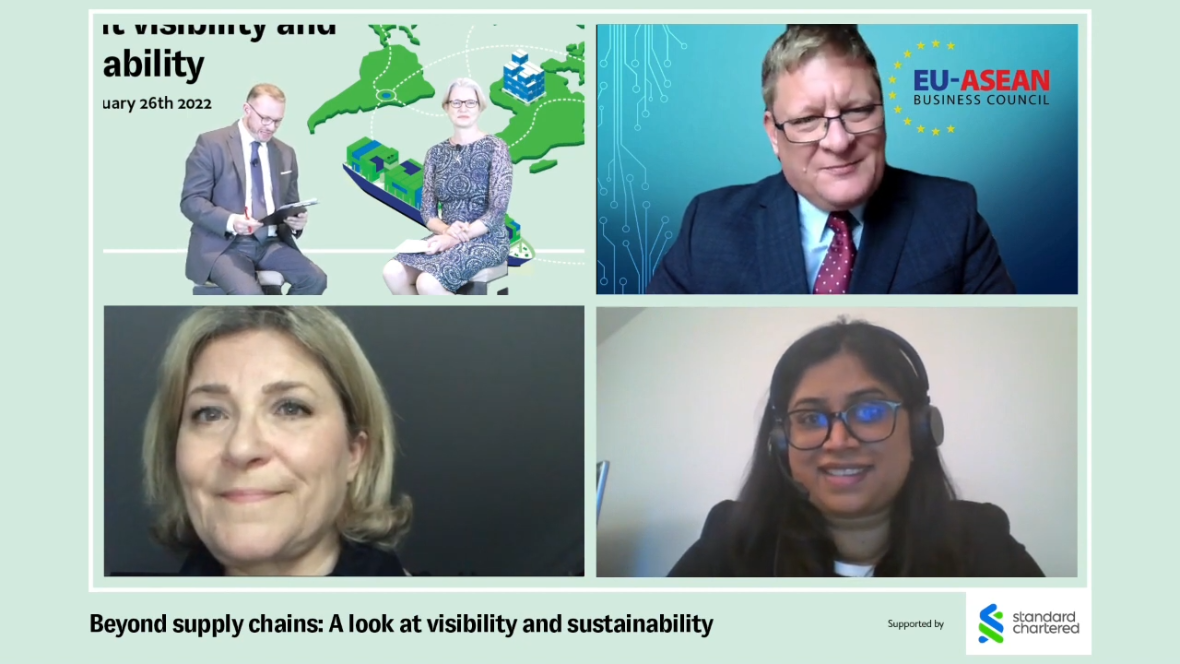Closing the possibility gap: making the sustainable future of trade a reality in Asia


Leaders from Wilmar International, Engie, Asian Development Bank and Standard Chartered discuss how companies can increase visibility along their supply chains.

Experts from Asian Trade Centre and Standard Chartered share their views on where SMEs need the most support, the tools needed to help reduce carbon footprints and more.

Panellists from MSCI, EU-ASEAN Business Council, European Investment Bank and Standard Chartered explore how financial institutions, investors, companies and governments can work together to harmonise reporting and ESG standards.

This decade will cement Asia’s position at the centre of global trade, with exports rising to US$11.5tn, up from US$5.8tn in 2020, according to The Future of Trade 2030, a new report by Standard Chartered. This shift in global trade flows not only provides significant growth opportunities for corporates, but also presents the potential to improve practices – particularly with regard to fairness, transparency and sustainability in supply chains.
In 2021 the United Nations’ “code red” warning on the IPCC’s sixth assessment report, followed by the Cop26 climate talks, helped focus business executives, investors and stakeholders on the need to improve performance related to environmental, social and governance (ESG) issues across their organisations.
Beyond high-level climate concerns, a rising wave of conscious consumerism and increased regulatory activity around ESG are fast making sustainable and fair trade standards and practices non-negotiable. Corporates are taking note: 89% of respondents to Standard Chartered’s global survey acknowledge the need to incorporate them across their supply chains.
But achieving this is often easier said than done, especially in a region criss-crossed by multiple tiers of suppliers across different jurisdictions. Speaking at a recent Economist Impact event, Beyond supply chains: A look at visibility and sustainability, three Standard Chartered experts outlined the key barriers, and provided insights on potential solutions.
“The majority of ESG risks to a corporate, such as carbon emissions or labour practices, are found in the supply chain,” says Pradeep Nair, global head, structured solutions and development, transaction banking, at Standard Chartered. “Increasingly, for corporates, getting it right means focusing on suppliers (or buyers), right the way down the chain.”
The first challenge lies around defining sustainability. Asia’s trading strength lies in its diversity, but with this heterogeneity comes a lack of uniform reporting requirements and standards. As the enforcement of global standards and frameworks to monitor adherence to sustainable practices gathers pace, regulatory actions such as the European Union (EU) proposal to impose a carbon tax on imports are injecting a further sense of urgency, particularly for multinational corporates (MNCs) operating in and trading with the region.
“The European market is several years ahead of Asia in terms of mandating ESG reporting, however the region is now moving at an accelerated pace,” says Roshel Mahabeer, head of clean tech and sustainable trade finance at Standard Chartered. She points to initiatives such as the Monetary Authority of Singapore’s Green Finance Industry Taskforce (GFIT), and the development of the ASEAN Taxonomy. “This is being done to keep pace with Europe, but also to ensure business continuity, since a multinational operating in Europe with a supply chain dependent on Asia, will be adopting its own operating standards and models into its supply chain.”
However, simply transposing what is being done in other regions throws up particular difficulties for Asia’s exporters.
“A regional lens has to be applied,” explains Mahabeer. “Relatively speaking, it’s easier for a manufacturer in Europe to decarbonise since the grid there is increasingly utilising renewable energy. A small-scale manufacturer in Bangladesh, for example, does not have that same ability to replace fossil fuels.”
Regulators in the region are taking this into account. Singapore’s proposed taxonomy, for example, encompasses transition activities that allow for a progressive shift towards greater sustainability while considering starting positions, thereby supporting inclusive economic and social development.
In the meantime, though, should SMEs be unable to improve their green credentials, they may face being replaced by competitors who can. A study by Standard Chartered, titled Carbon Dated, found that 78% of MNCs will remove suppliers that endanger their carbon transition plan by 2025.
“Corporates are – rightly – insisting on sustainable suppliers and producers, but some, particularly at the smaller end of the scale, lack the infrastructure, know-how and resources to comply. Often, a supplier may be catering to multiple buyers, each with different criteria, and that creates conflicts and cost implications for our clients,” says Nair.
Paradoxically, a greater focus on ESG risks IS shutting out those smaller suppliers in emerging markets that could benefit from it the most. To avoid this contradictory situation, a concerted effort from all participants is needed to lower the barriers to entry to sustainable trade.
There are numerous indicators that this is already taking place. To help their suppliers’ transition to net zero, 47% of MNCs said they were offering preferred supplier status – a sales advantage – to sustainable suppliers, and 30% are offering preferential pricing.
Financing is also increasingly being used to help suppliers shift to more sustainable practices, with 80% of corporates polled by Standard Chartered saying that partnering with banks to promote access to finance is a key priority. “Suppliers are improving standards according to what MNCs are dictating in terms of procurement, and this can now be very easily tied into a financing structure,” says Mahabeer.
While many companies are prioritising their immediate suppliers for actions related to sustainability, gaining control and visibility over the deeper tiers of suppliers can make the most difference.
“The support is actually needed beyond tier one, right the way down to the producer level,” says Kai Fehr, global head of trade and working capital at Standard Chartered.
Financing can be used to drive sustainable practices across the entire chain, as well as ensure that each supplier has enough working capital to meet their obligations. For example, through its sustainability-linked financing solutions, Standard Chartered works with customers and partners to finance underlying goods that meet agreed sustainability standards. The bank also supports trade for clients’ suppliers who meet acceptable thresholds against ESG ratings or metrics such as gender equality, responsible sourcing criteria and water use.
Through a partnership with supply chain technology solution provider Linklogis (LLS) in China, the Bank is now taking sustainable supply chain financing into the deep tiers. “The LLS platform creates a financial token based on an irrevocable payment undertaking (IPU) by an anchor buyer which can be passed down to several levels of suppliers. This achieves two things – ability to reach further and better visibility on where financing is needed,” explains Fehr. ”Using this technology, we have been able to reach the 11th levels of supply chains.”
Over half of all corporates in Asia say that they are prioritising de-risking their supply chain and realigning their footprint to protect against external shocks, leading to new opportunities for resilient growth with the potential to have a broader environmental and societal impact.
“The coming months are likely to see continued disruption,” says Fehr. “Those corporates that are working with their banks to ensure they have visibility into their supply chain and that their suppliers are well-financed will stand the greatest chance of weathering any storms to come – while ensuring that their trade activity contributes to a better, more equitable future.”
It is impossible to forecast what the rest of this decade will bring for Asia’s supply chains. However, with the right building blocks in place, the region stands to play a leading role in helping global trade reach its sustainability potential, paving the way for more inclusive participation in a system that works for all.